S&P Global Offerings
Featured Topics
Featured Products
Events
S&P Global Offerings
Featured Topics
Featured Products
Events
S&P Global Offerings
Featured Topics
Featured Products
Events
Banking & Capital Markets
Economy & Finance
Energy Transition & Sustainability
Technology & Innovation
Podcasts & Newsletters
Banking & Capital Markets
Economy & Finance
Energy Transition & Sustainability
Technology & Innovation
Podcasts & Newsletters
S&P Global Offerings
Featured Topics
Featured Products
Events
Research — 29 Nov, 2023

By Keith Nissen
Approximately nine in 10 children ages 6-12 and teenagers ages 13-17 in the US have access to at least one internet-connected device for personal use, according to recent Kagan Consumer Insights surveys. This generally compares to the levels of device ownership among children in China, South Korea and India.

➤ Ownership of smartphones and tablets among teenagers in the US is generally on par with their Asian counterparts. The use of tablets among US preteens, defined as children ages 6-12, is higher than in Asia.
➤ US teens and preteens are more likely to have a personal TV, PC or video game console than those in Asia.
➤ In the US, the majority of those purchasing internet-connected devices for resident teenagers and preteens have an annual income in the middle 50% of internet households. In Asia, a higher percentage of households purchasing connected devices for children are in the top 20% income bracket.

The Kagan 2023 Asia Consumer Insights survey and the Kagan third-quarter 2023 US survey asked households with children what internet-connected devices their children have for personal use (not shared). The US survey showed that among households with resident teenagers (ages 13-17) 94% of teens have at least one internet-connected device for personal use. Households with younger children, ages 6 to 12, reported similar overall results, with 88% of preteens in the US having a connected device. These totals are also very similar to the findings from the Asia survey conducted in China, South Korea and India.
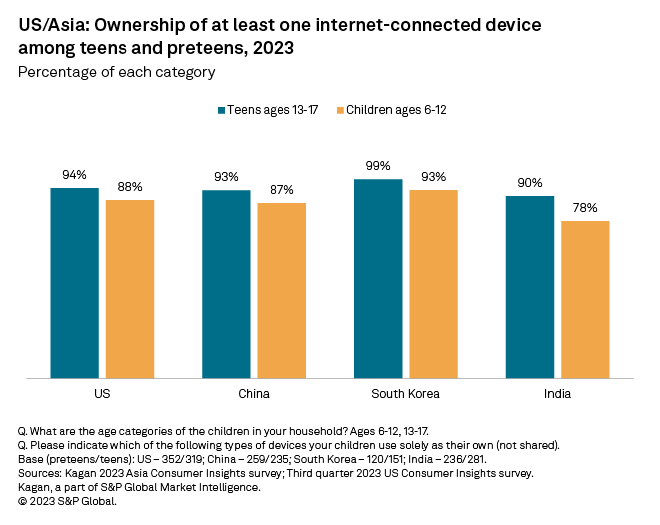
Smartphones are the most popular internet-connected devices owned by teenagers in the US and Asia. The survey found that 82% of US teenagers have a smartphone for personal use. Only South Korea has a higher level of smartphone use by teenagers (91%). Teen ownership of tablets is almost half (39%) of smartphones in the US but is generally on par with that of South Korea (46%) and China (44%). The exception is India, where only 27% of teens have tablets. In contrast, teen ownership of smartwatches is low in the US (18%) compared to India (43%), China (34%) and South Korea (25%).
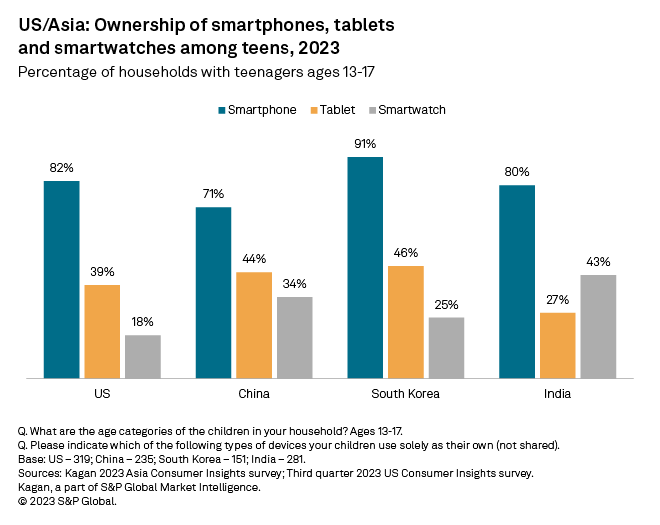
The survey results also show that about half (46%) of US preteens own a smartphone. This is substantially lower than South Korea (79%) and India (56%). Only China has a lower level of smartphone use (36%) by preteens than the US. In contrast, nearly two-thirds (62%) of US parents with preteenage children report providing their preteen with a tablet. In comparison, far fewer preteens in Asia have a tablet for personal use. This suggests that parents in the US may be providing their younger children with tablets to watch online video, rather than relying exclusively on TV entertainment.
The survey data also shows that very few preteens in the US have their own smartwatch, and smartwatch use among preteens in India and South Korea is also modest. However, nearly half (45%) of parents with preteens in China reported providing their children with a smartwatch, possibly as an alternative to a smartphone.
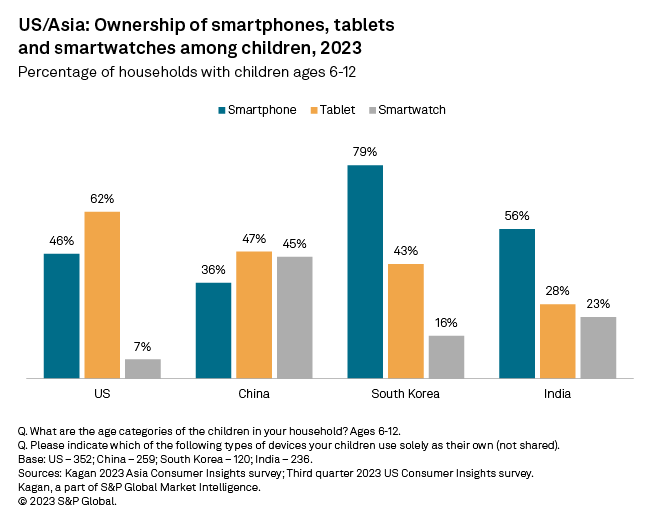
Over half of parents in the US (52%) said their teenagers have a TV for personal use. India is not far behind, with 40% of teenagers having a personal TV. Yet, the survey data shows that personal TVs are relatively rare in China (18%) and South Korea (10%). Similarly, the survey found that about half (49%) of US teenagers have a personal computer and a video game console, more than double that of China.
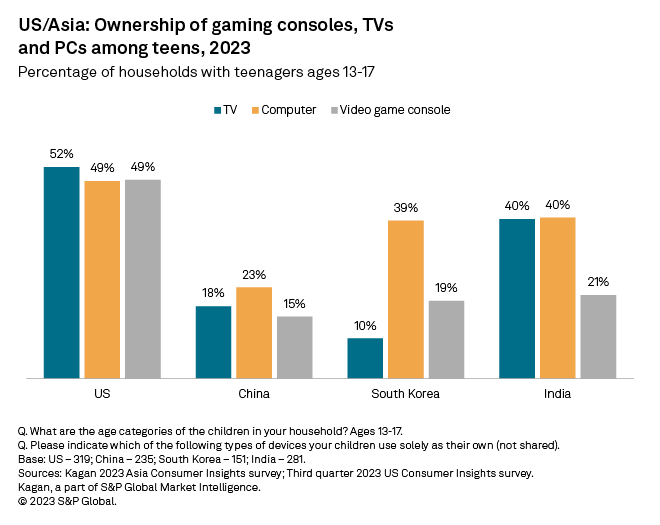
The survey found that preteens in the US are nearly as likely to have their own TV as their older teenage siblings. Nearly half (45%) of US parents with preteens said their children, ages 6 to 12, have a TV for personal use. This is more than double that of preteens in China and South Korea, where only 20% and 17% of preteens, respectively, have their own TV. US pre-teenage children are also more likely to have a video game console than their Asian counterparts. Ownership of PCs among preteens in the US is generally on par with that of India but is substantially higher than in China or South Korea.
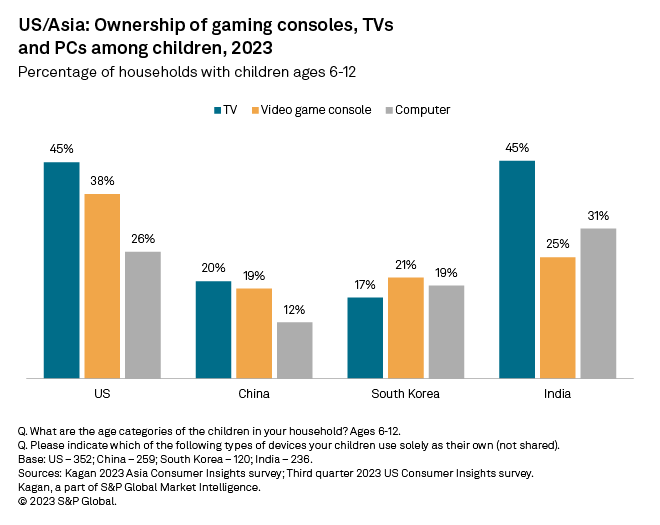
In theory, high-income households might be more likely to buy internet-connected devices such as smartphones or smartwatches for their children than low-income households. Taking the US as an example, the survey data reveals that device ownership among children is generally in line with the household income distribution of the overall survey. The data shows that among US households with children ages 6 to 12, 18% are high-income households. Approximately six in 10 (59%) preteen households fall into the middle-income income bracket, while 23% are low-income households.
In Asia, preteen ownership of internet-connected devices tends to be skewed more toward high-income households than in the US. In China, for example, approximately 4 in 10 (39%) preteen households are in the high-income bracket, compared to only 13% in low-income households. Only 7% of preteen households in South Korea are in the bottom income bracket, while two-thirds (67%) are middle-income households. The major takeaway is that household income directly correlates with a parent's decision to buy a connected device for their preteen children but that middle-income households are just as likely to do so as their wealthy neighbors.
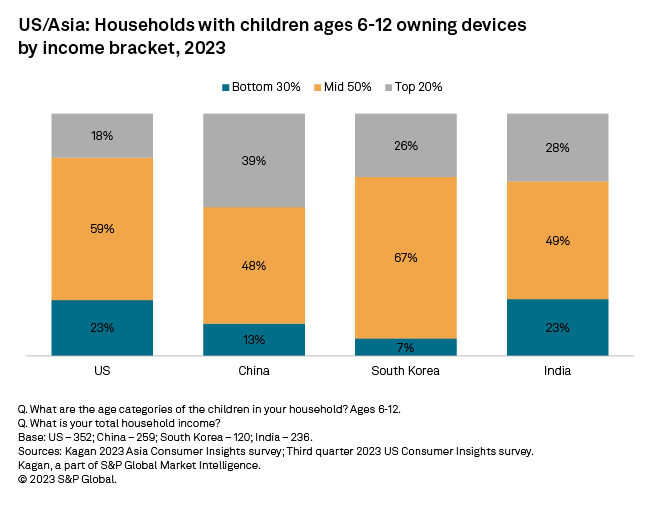
To submit direct feedback/suggestions on the questions presented here, please use the "feedback" button located above, directly under the title of this article. Note that while all submissions will be reviewed and every attempt will be made to provide pertinent data, Kagan is unable to guarantee inclusion of specific questions in future surveys.
Consumer Insights is a regular feature from Kagan, a part of S&P Global Market Intelligence.
This article was published by S&P Global Market Intelligence and not by S&P Global Ratings, which is a separately managed division of S&P Global.
